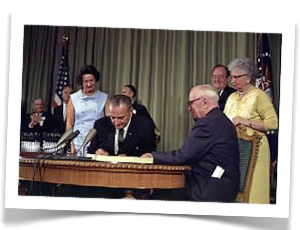This history of medicare starts with the Social Security Act in 1965 establishing both the Medicare and Medicaid healthcare insurance systems. Although, both healthcare systems were governed by different offices. Medicare was the responsibility of the Social Security Administration or SSA, while the State Medicaid programs were administered and looked after by the Social and Rehabilitation Service or SRS. Both of these agencies are within the Department of Health, Education, and Welfare system or HEW.
 During 1977, the Health Care Financing Administration was created under the HEW system to ensure that the healthcare systems were effectively coordinated. HEW was then divided into two separate systems, the Department of Education and the Department of Health and Human Services or HHS in 1980.
During 1977, the Health Care Financing Administration was created under the HEW system to ensure that the healthcare systems were effectively coordinated. HEW was then divided into two separate systems, the Department of Education and the Department of Health and Human Services or HHS in 1980.
Harry S. Truman was the first U.S. President to propose a prepaid health insurance plan on November 19, 1945. He proposed this in a special message to the Congress. He outlined a comprehensive prepaid medical insurance plan for all the people who were in the Social Security system. This system was dubbed the ‘National Health Insurance’ and it included doctors, hospitals, nursing, labs, and dental services. The insurance was to be funded by Federal revenues.
As the years passed, lawmakers narrowed the health insurance coverage to more social security beneficiaries than others. In a national survey given, only 56 percent of persons aged 65 years of older had health insurance. President John F. Kennedy pushed for health insurance for the aged. It was not until 1965, from President Lyndon B. Johnson that the health care covered for the aged was recognized. President Johnson signed the H.R. 6675 or the Social Security Act of 1965. This provided health insurance for the elderly and the poor.
President Johnson then signed the Medicare and Medicaid Bill on July 30, 1965 in Independence, Missouri in the presence of former President Truman. He received the first Medicare card at the ceremony.
Medicare then extended their health coverage to almost any and all Americans who were the age of 65 or older. This allowed over 19 million beneficiaries to enroll in Medicare during the first year that it was passed. Medicaid provided extra access to health care services for low income persons and then expanded the pre existing Federal State welfare structure that assisted the poor.
The Social Security Amendments expanded Medicare health coverage to provide more coverage to two additional groups that were deemed high risk such as disabled persons and persons who suffered from end stage renal disease in 1972. On December 8, 2003 the Medicare Prescription Drug Improvement and Modernization Act was signed by President George W. Bush. This provided seniors and disables persons to a prescription drug benefit with more health care choices with better benefits overall.




